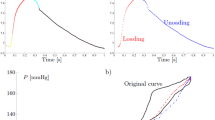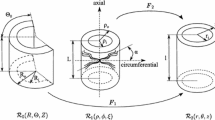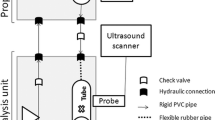Abstract
This study suggests a method to compute the material parameters for arteries in vivo from clinically registered pressure-radius signals. The artery is modelled as a hyperelastic, incompressible, thin-walled cylinder and the membrane stresses are computed using a strain energy. The material parameters are determined in a minimisation process by tuning the membrane stress to the stress obtained by enforcing global equilibrium. In addition to the mechanical model, the study also suggests a preconditioning of the pressure-radius signal. The preconditioning computes an average pressure-radius cycle from all consecutive cycles in the registration and removes, or reduces, undesirable disturbances. The effect is a robust parameter identification that gives a unique solution. The proposed method is tested on clinical data from three human abdominal aortas and the results show that the material parameters from the proposed method do not differ significantly (p < 0.01) from the corresponding parameters obtained by averaging the result from consecutive cycles.
Similar content being viewed by others
References
Åstrand H, Ryden-Ahlgren Å, Sandgren T and Länne T (2005). Age-related increase in wall stress of the human abdominal aorta: an in vivo study. J Vasc Surg 42: 926–931
Bailey AJ, Paul RG and Knott L (1998). Mechanism of maturation and ageing of collagen. Mech Ageing Dev 106: 1–56
Boudaoud S, Rix H, Meste O, Heneghan C, O’Brian C (2007) Corrected integral shape averaging applied to obstructive sleep apnea detection from the electrocardiogram. EURASIP J Adv Signal Process 2007:1–12, doi:10.1155/2007/32570
Cattell MA and Anderson JC (1996). Age-related changes in amounts and concentration of collagen and elastin in normotensive human thoracic aorta. Clin Chim Acta 245: 73–84
Fectics B, Nevo E, Chen CH and Kass DA (1999). Parametric Model Derivation of Transfer Function for Noninvasive Estimation of Aortic Pressure by Radial Tonometry. IEEE Trans Biomed Engrg 46: 698–706
Flügge W (1975). Viscoelasticity. Springer, New York
Hansen F, Mangell P, Sonesson B and Länne T (1995). Diameter and compliance in the human common carotid artery—variation with age and sex. Ultrasound Med Biol 21: 1–9
Holzapfel GA (2000). Nonlinear solid mechanics, a continuum approach for engineering. Wiley, Chichester
Holzapfel GA, Gasser TC and Ogden RW (2000). A new constitutive framework for arterial wall mechanics and a comparative study of material models. J Elasticity 61: 1–48
Holzapfel GA, Sommer G, Gasser TC and Regitnig P (2005). Determination of layer-specific mechanical properties of human coronary arteries with nonatherosclerotic intimal thickening and related constitutive modeling. Am J Physiol 289: H2048–H2058
Humphrey JD (2002). Cardiovascular solid mechanics. Cells, tissues and organs. Springer, New York
Kawasaki T, Sasayama S, Yagi S-I, Asakawa T and Hirai T (1987). Non-invasive assessment of the age related changes in stiffness of major branches of the human arteries. Cardiovasc Res 21: 678–687
Ljung L (1999). System identification—theory for the user. 2nd. PTR Prentice Hall, Upper Saddle River
Länne T, Sonesson B, Bergqvist D, Bengtsson H and Gustafsson D (1992). Diameter and compliance in the male human abdominal aorta: influence of age and aortic aneurysm. Eur J Vasc Surg 6: 178–184
Nichols WW and O’Rourke MF (2005). McDonald’s blood flow in arteries. Theoretical, experimental and clinical principles. Hodder Arnold, London
Peterson LH, Jensen RE and Pernell J (1960). Mechanical properties of arteries in vivo. Circ Res 8: 622–633
Rhodin JG (1980) Architecture of the vessel wall. In: Bohr DF, Somlyo AD, Sparks HV (eds) Handbook of physiology, the cardiovascular system, vol. 2, pp 1–31
Ryden-Ahlgren Å, Åstrand H, Sandgren T, Vernersson E, Sonesson B and Länne T (2001). Dynamic behaviour of the common femoral artery: age and gender of minor importance. Ultrasound Med Biol 27: 181–188
Schulze-Bauer CAJ and Holzapfel GA (2003). Determination of constitutive equations for human arteries from clinical data. J Biomech 36: 165–169
Schulze-Bauer CAJ, Regitnig P and Holzapfel GA (2002). Mechanics of the human femoral adventitia including high-pressure response. Am J Physiol 282: H2427–H2440
Schulze-Bauer CAJ, Mörth C, Holzapfel GA (2003) Passive Biaxial Mechanical Response of Aged Human Iliac Arteries. J Biomech Engrg 125:395–406. doi:10.1115/1.1574331
Singh SI and Devi LS (1990). A study on large radial motion of arteries in vivo. J Biomech 23: 1087–1091
Sonesson B, Hansen F, Stale H and Länne T (1993). Compliance and diameter in the human abdominal aorta—the influence of age and sex. Eur J Vasc Surg 7: 609–697
Sonesson B, Länne T, Vernersson E and Hansen F (1994). Sex difference in the mechanical properties of the abdominal aorta in human beings. J Vasc Surg 20: 959–969
Stålhand J and Klarbring A (2005). Aorta in vivo parameter identification using an axial force constraint. Biomechan Model Mechanobiol 3: 191–199
Stålhand J and Klarbring A (2006). Parameter identification in arteries using constraints. In: Holzapfel, GA and Ogden, RW (eds) Mechanics of biological tissues, pp 295–305. Springer, Wien,
Stålhand J, Klarbring A and Karlsson M (2004). Towards in vivo aorta material identification and stress estimation. Biomechan Model Mechanobiol 2: 169–186
Author information
Authors and Affiliations
Corresponding author
Rights and permissions
About this article
Cite this article
Stålhand, J. Determination of human arterial wall parameters from clinical data. Biomech Model Mechanobiol 8, 141–148 (2009). https://doi.org/10.1007/s10237-008-0124-3
Received:
Accepted:
Published:
Issue Date:
DOI: https://doi.org/10.1007/s10237-008-0124-3




